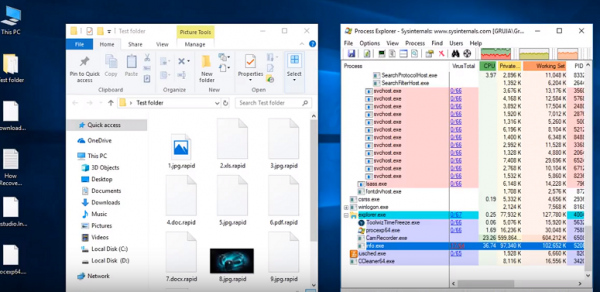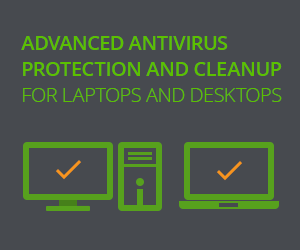Rapid ransomware has been around since the first days of 2018. The first case approved by trusted security labs dates back to January 3. Since that, some 300 cases were reported to ID-ransomware database only. The actual number of victims is likely to be much greater, and other reports may flow to databases other than the one above.

Rapid ransomware is somewhat true to its name as it is quick to scramble any data entering a hacked device. First of all, of course, the infection encrypts the files already in the computer memory at the time of its installation.
Ransom Trojans are not at all interested in getting down the entire computer system. That is not an act of mercy. That is just because the ransom, to be paid, needs the one who is expected to pay; this is going to be the one who is at least aware that the ransom, once paid, recovers or avoids the damage caused. In plain English, the infection needs to notify the user concerned of its attack, and the most obvious and shortest way to such a notification is via the same hacked device. That is why the encryption omits certain folders and types of files. The system keeps running and the ransom note is available to the victim’s attention.
Prior to the notification and the encryption, the Rapid ransomware ensures the recovery is not going to be done in a breeze. It deletes Shadow Copies in Windows, kills database processes and hinders recovery options. In particular, the infection terminates SQL and Oracle processes. Instead, it launches its own processes preparing for the encryption.
The encryption uses a strong mix of AES and RSA algorithms. So far, interception attempts aimed at obtaining the decryption key have been to no avail. Meanwhile, the encryption is strong enough to withstand brute-force based recovery methods.
The infection adds a .rapid extension to the names of the files it hits. It does not modify other names of the files.
The ransom note created by the infection is available in nearly any folder. Besides, the infection tries to launch it automatically. It is typically available as a file named How Recovery Files.txt.
Last but not least, Rapid ransomware neither removes itself not terminates its processes once the initial encryption is done. It is looking for any new entries of data encrypting any fresh ones.
Consequentially, removal of Rapid ransomware is an essential part of the response to its invasion. Complete guidance on the recovery and removal for Rapid ransom trojan is available below.
Automatic removal of Rapid Ransomware
The benefits of using the automatic security suite to get rid of this infection are obvious: it scans the entire system and detects all potential fragments of the virus, so you are a few mouse clicks away from a complete fix.
- Download and install recommended malware security suite
- Select Start Computer Scan feature and wait until the utility comes up with the scan report. Proceed by clicking on the Fix Threats button, which will trigger a thorough removal process to address all the malware issues compromising your computer and your privacy.
Restore files locked by Rapid Ransomware
new Locky variant aka Rapid Ransomware represents a unique category of malicious software whose attack surface reaches beyond the operating system and its components, which is why removing the virus itself is a part of the fix only. As it has been mentioned, it encrypts one’s personal information, so the next phase of the overall remediation presupposes reinstating the files that will otherwise remain inaccessible.
-
-
Launch data recovery software
Similarly to the rest of its fellow-infections, Rapid Ransomware most likely follows an operational algorithm where it erases the original versions of the victim’s files and actually encrypts their copies. This peculiarity might make your day, because forensics-focused applications like Data Recovery Pro are capable of restoring the information that has been removed. As the virus further evolves, its modus operandi may be altered – in the meanwhile, go ahead and try this.
-
-
Take advantage of Volume Shadow Copy Service
This technique is based on using the native backup functionality that’s shipped with Windows operating system. Also referred to as Volume Snapshot Service (VSS), this feature makes regular backups of the user’s files and keeps their most recent versions as long as System Restore is on. Rapid Ransomware hasn’t been found to affect these copies therefore the restoration vector in question is strongly recommended. The two sub-sections below highlight the automatic and manual workflow.
- a) Use Shadow ExplorerShadow Explorer is an applet that provides an easy way of retrieving previous versions of files and folders. Its pro’s include an intuitive interface where the computer’s entire file hierarchy is displayed within one window. Just pick the hard disk volume, select the object or directory to be restored, right-click on it and choose Export. Follow the app’s prompts to get the job done.

- b) Use file propertiesEssentially, what the above-mentioned Shadow Explorer tool does is it automates the process that can otherwise be performed manually via the Properties dialog for individual files. This particular approach is more cumbrous but just as effective as its software-based counterpart, so you can proceed by right-clicking on a specific file, which has been encrypted by Rapid Ransomware, and selecting Properties in the context menu. The tab named Previous Versions is the next thing to click – it displays available versions of the file by date of the snapshot creation. Pick the latest copy and complete the retrieval by following the prompts.

-
Data backups work wonders
Ransomware like Rapid Ransomware isn’t nearly as almighty and destructive in case you run regular file backups to the cloud or external data media. The virus itself can be completely removed in a matter of minutes, and the distorted information can then be just as easily recovered from the backup. Luckily, this is a growing trend, so ransom Trojans are hopefully going to become less subversive in the near future.
Verify thoroughness of the removal
Having carried out the instructions above, add a finishing touch to the security procedure by running an additional computer scan to check for residual malware activity
